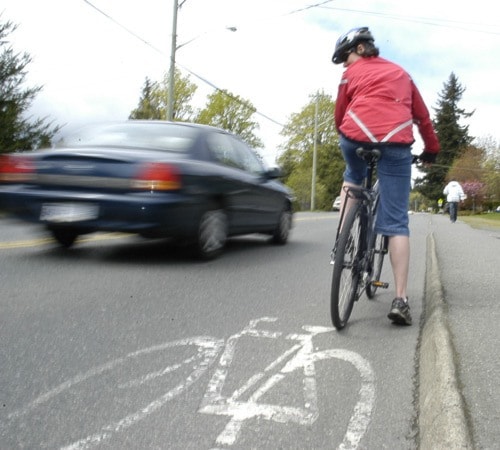Bike? Check. Helmet? Check.Interest in staying healthy, feeling good and reducing greenhouse gas emissions?
Check, check and check.
Awesome.
But where in the heck do you ride this thing on roads that won’t stress you out, put you in danger or cause you to blow a lung climbing one of Nanaimo’s notorious hills?
Great question.
Mapping out a safe and efficient bike route to get you to work and back takes a little planning, but not as much as you might think.
As local cycling guru Richard Littlemore notes, drivers and cyclists have very different priorities when it comes to choosing a route to commute on.
“Drivers tend to want straight, wide roads with high speed limits – most seem to want no speed limit whatsoever,” said Littlemore. “Cyclists want trails with no traffic, or back streets with only the odd, slow moving car.”
Fortunately, Nanaimo has a plethora of scenic and direct side streets that run parallel to busy motorways that cyclists can choose.
What’s more, in 1994 the city recognized a need to improve cycling infrastructure to allow the ever-increasing amount of cyclists using local roadways safe and efficient passage and has been addressing the issue since.
As a result, great trailways like the E&N Trail and Parkway Trail have become common routes for cyclists, while busy roads like Departure Bay Road accommodate cyclists with dedicated lanes due to an increased road width from the standard 3.9 metres across to 4.7 metres.
Gord Foy, city engineer, said cycling routes are on the radar when road improvements are made.
“Whenever we upgrade a road, we consider if a cycling lane is a viable addition to that improvement,” said Foy. “And we do the same for pedestrians. Wherever we can improve access for all modes of transportation we try to do it.”
A key example of local improvements for cyclists includes the upgrade of Bowen Road near the Quarterway Bridge.
In what was previously a sketchy area for cyclists due to high speeds and a narrow roadway, once the project is complete in 2012, cyclists and pedestrians will have an excellent route to access the downtown and university areas.
To view all of Nanaimo’s 180-plus kilometres of bike routes and trails, visit www.nanaimo.ca, click on the ‘departments’ tab and follow it to parks, recreation and culture.
Once there, click on ‘parks, trails and field’ and look for the cycling link in the tab bar on the left. A brochure highlighting the city’s bike routes can be downloaded, and the city says it will be updated this month, just in time for Bike To Work Week 2011 (May 30 to June 5).
Another project on the go is the city’s first dedicated bike lane on Fourth Street that, at Vancouver Island University’s urging, will give a viable option for students and other commuters to ride safely back and forth to the campus from nearby neighbourhoods.
So the infrastructure is there and improving but the practical question remains: Which route do you take to get to work on your bike?
David Grey, president of the Greater Nanaimo Cycling Coalition, said the initial challenge is to find a route within your comfort zone and to give the route a practice run to ensure it meets your needs as a cyclist.
“Don’t overdo it to start,” said Grey. “Build up to it. You don’t want to get to work so tired and sweaty that you’re uncomfortable. Riding your bike should be a stress release, not stressful. So don’t push too far, plan ahead and ease your way into it.”
One of the most important aspects of a good route is flow. Having to constantly stop and start, or even dismount, can kill a cyclist’s mojo, as can traffic lights that can’t be tripped by a cyclist’s weight, resulting in long waits.
A good route requires little stopping, minimal hills, few cars and even quick little deeks through park trails or side streets that enhance the adventure value and make cycling more enjoyable.
“If you come across something like lights that don’t change for cyclists or unsafe road conditions, let the city know,” said Grey. “They are very fast at responding.”
Littlemore said exploring a bicycle route doesn’t necessarily have to be done by bicycle.
“This exploration might appropriately occur in a car and/or on foot,” he said.
For more information on Bike To Work Week and other route planning tips, visit www.biketowork.ca/nanaimo or www.thegncc.org and help Nanaimo celebrate the bicycle.
Fast or safe? Find your comfort level
Anyone who has driven in downtown Vancouver lately will have noticed that bicycle couriers seem never to ride in bicycle lanes. With a tight schedule and an apparent disregard for traffic laws or personal safety, they’re forever choosing the shortest distance between two points – even if it means cutting right in front of you.
That’s not how cycle commuting should work. Depending on your risk tolerance, you’ll want to find a route that avoids traffic without taking you too far out of the way.
But here’s one area where you shouldn’t ask for advice. Find something that feels right – for you – and then be confident that you picked the right route.
Richard Littlemore, director
Greater Nanaimo Cycling Coalition
Keep following the News Bulletin’s six-part series (part 1 was published April 21) on what it takes to try bicycle commuting in the weeks leading up to Bike To Work Week, which takes place May 30 to June 5.
